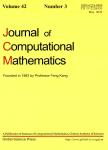A MIXED VIRTUAL ELEMENT METHOD FOR THE BOUSSINESQ PROBLEM ON POLYGONAL MESHES
作者机构:CI^2 MA and Departamento de Ingenieria MatemiticaUniversidad de ConcepcionCasilla 160-CConcepcionChile Escuela de MatemaiticaUniversidad NacionalCampus Omar DengoHerediaCosta Rica
出 版 物:《Journal of Computational Mathematics》 (计算数学(英文))
年 卷 期:2021年第39卷第3期
页 面:392-427页
核心收录:
学科分类:07[理学] 0714[理学-统计学(可授理学、经济学学位)] 0701[理学-数学] 0812[工学-计算机科学与技术(可授工学、理学学位)]
基 金:supported by CONICYT-Chile through the project AFB170001 of the PIA Program:Concurso Apoyo a Centros Cientificos y Tecnologicos de Excelencia con Financiamiento Basal,and the Becas-CONICYT Programme for foreign students by Centro de Investigacion en Ingenieria Matematica(CI^(2)MA),Universidad de Con-cepcion by Uniyersidad Nacional,Costa Ricea,through the prejeet 0103-18.
主 题:Boussinesq problem Pseudostress-based formulation Augmented formulation Mixed virtual element method.High-order approximations
摘 要:In this work we introduce and analyze a mixed virtual element method(mixed-VEM)for the two-dimensional stationary Boussinesq problem.The continuous formulation is based on the introduction of a pseudostress tensor depending nonlinearly on the velocity,which allows to obtain an equivalent model in which the main unknowns are given by the aforementioned pseudostress tensor,the velocity and the temperature,whereas the pressure is computed via a postprocessing formula.In addition,an augmented approach together with a fixed point strategy is used to analyze the well-posedness of the resulting continuous formulation.Regarding the discrete problem,we follow the approach employed in a previous work dealing with the Navier-Stokes equations,and couple it with a VEM for the convection-diffusion equation modelling the temperature.More precisely,we use a mixed-VEM for the scheme associated with the fluid equations in such a way that the pseudostress and the velocity are approximated on virtual element subspaces of H(div)and H^(1),respectively,whereas a VEM is proposed to approximate the temperature on a virtual element subspace of H^(1).In this way,we make use of the L^(2)-orthogonal projectors onto suitable polynomial spaces,which allows the explicit integration of the terms that appear in the bilinear and trilinear forms involved in the scheme for the fluid equations.On the other hand,in order to manipulate the bilinear form associated to the heat equations,we define a suitable projector onto a space of polynomials to deal with the fact that the diffusion tensor,which represents the thermal conductivity,is variable.Next,the corresponding solvability analysis is performed using again appropriate fixed-point arguments.Further,Strang-type estimates are applied to derive the a priori error estimates for the components of the virtual element solution as well as for the fully computable projections of them and the postprocessed pressure.The corresponding rates of convergence are also established.Finally,several numerical examples illustrating the performance of the mixed-VEM scheme and confirming these theoretical rates are presented.



